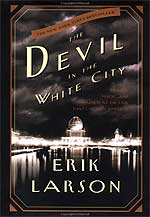« The Kite Runner - Khaled Hosseini | Home | On the Water - Nathaniel Stone »
May 18, 2005
The Devil in the White City - Erik Larson
Erik Larson's The Devil in the White City is the true story of the building of the magnificent 1893 Columbian Exposition World's Fair in Chicago and the sociopath murderer H.H. Holmes who preyed on young women coming to see the fair. In his telling, Larson transports us to the late 1800s from when Chicago first wins the right by Congressional vote to host the fair, beating out rival New York City, through the two years it took to build the White City, to the fair itself, which brought in an estimated 40 million visitors during the short time it was open. Daniel H. Burnham, chief architect of the fair, led the extraordinary effort to build the fair, a feat no one thought could be accomplished in the time given. The fair drew the best engineers, architects, and designers the country had and forever transformed the shoreline of Chicago. The result was such a resounding success, Bernham imprinted grandeur into the minds of visitors who came from all over the country and set the course of American neo-classical architecture for the next fifty years.
A few miles away, in the Chicago suburb Englewood, a more sinister story was unfolding. Dr. H.H. Holmes built a boarding house on a full city block, complete with torture chamber and crematorium in its basement. On the first floor of the building Holmes ran a pharmacy, complete with bogus cure-alls, a restaurant, and several seemingly respectable businesses - fronts for countless fraud schemes.
A handsome, arresting, blue-eyed man, Holmes charmed several women into working for him, or renting a room while in town visiting the fair. He seduced them, mesmerized them, and killed scores of them, either by locking them in an airtight vault and gassing them with poisonous fumes, or smothering them with ether-soaked rags. With several, he dissected them, removed their skin, and sold their bodies to be made into skeletons for local medical schools. He was a predator of the worst kind, a sociopath who preyed on the vulnerable, addicted to the thrill of killing.
One wouldn't expect that the two stories - of the Fair and of Holmes - would work so well together, intermingled in their telling. But in a way, the contrast between the two draws the picture of each even more vividly. It reminds me of David Lynch's Blue Velvet, where beneath the surface of a neatly manicured lawn in happy town USA, a severed finger rots. The story of the Fair shows the best of the men of the time - their engineering feats, their artistic ambition, their incredidbly hard work, their accomplishment when working united to a purpose; where the story of Holmes displays man at his worst. Larson does a terrific job weaving both tales together, and setting a pace that makes it hard to put the book down.
One interesting factoid I learned in the reading of this book is that the "Ferris Wheel" was designed by an engineer named Ferris, specifically for the Fair, a way to show up Mr. Eiffel and France's Eiffel Tower. The Ferris wheel of the Chicago fair, was however much grander than those which we now see at local carnivals.
I listened to the audiobook version which was very well done. The narrator is Scott Brick, who also narrated The Time Traveler's Wife. The audiobook is available at Audible.com.
Links:
Joyce Wycoff's excellent review of Devil and the White City
Posted by elise at 4:27 PM
to Audio book, History
